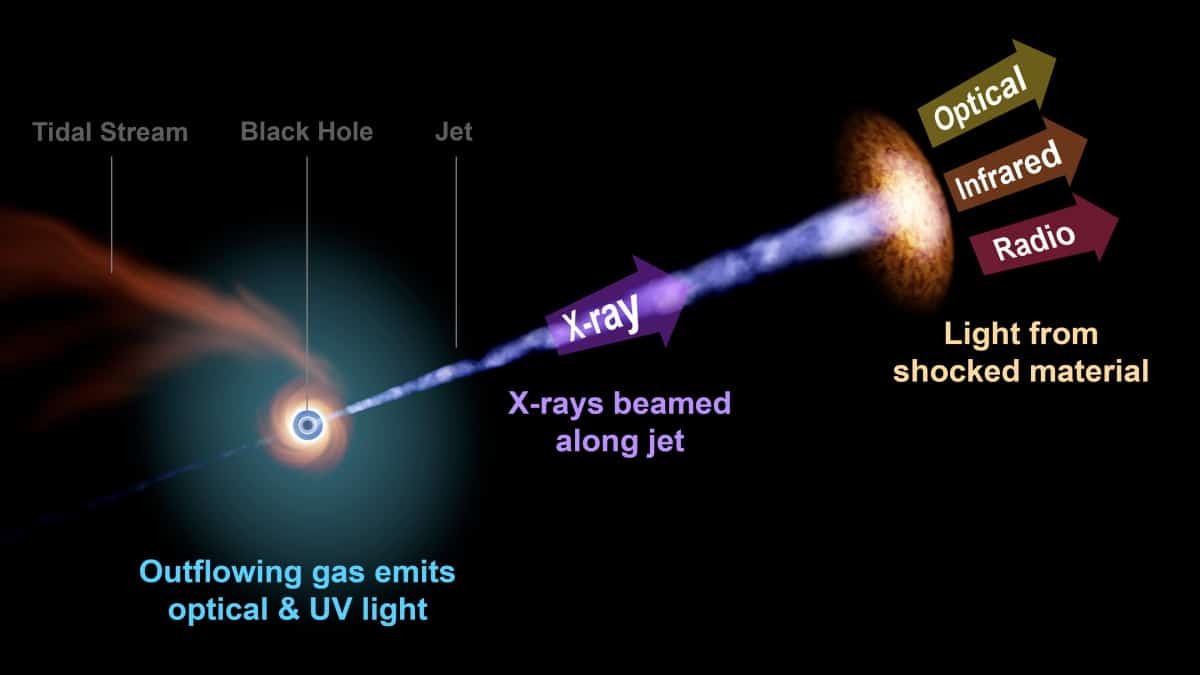12.12.2022

Tidal disruption event A black hole devours a star that has come too close. In rare circumstances, this may also result in jets moving with almost the speed of light that generate light at many frequencies. (Courtesy: Zwicky Transient Facility/R Hurt (Caltech/IPAC))
A star ripped apart by a supermassive black hole in a distant galaxy has been caught producing a rare but powerful jet of particles travelling at nearly the speed of light. The discovery, initially made by the Zwicky Transient Facility (ZTF) at Palomar Observatory in California, is the first time such a jet has been seen at optical wavelengths, and it is shedding light on how the star met its demise.
Such events are referred to as tidal disruption events, or TDEs, wherein ferocious gravitational tides from the black hole are able to twist and tear apart an entire star, sometimes in a matter of days, reducing it to a string of matter that spirals into the black hole in a process colourfully described as “spaghettification”. If too much matter piles up at the black hole’s maw, some of it can be spat away in a magnetically collimated jet.
The ZTF spotted the initial flare of light from the TDE, catalogued as AT2022cmc, on 11 February 2022, and subsequent observations with the European Southern Observatory’s Very Large Telescope pinned down its redshift as being 1.19, placing it in a galaxy at a distance of 8.5 billion light years.
For such a violently luminous TDE to occur, the star had to get very close to the black hole. In our Milky Way, stars have been observed orbiting as close as 1.9 billion kilometres to the supermassive black hole at the heart of our galaxy. But in the case of AT2022cmc, the unfortunate star could have come as close as 70 million kilometres, equivalent to about 100 solar radii.
Relativistic beaming
TDEs are observed in relatively nearby galaxies about once per month on average, but in most cases they are not accompanied by a relativistic jet – the light that we see comes from the thermal emission of the spiralling disc of material formed from the wrecked star. TDEs with jets are far rarer, and this is the first time a jet has been seen in the optical, boosted by a phenomenon known as “relativistic beaming”, whereby because the jet is pointing directly at us, the light it emits is rendered brighter by the Doppler effect.
“[AT2022cmc] is the first time we’ve found a TDE with an unambiguously super-strong relativistic jet, and the first time we’ve discovered a TDE through its jetted emission since 2011,” says Matt Nicholl of the University of Birmingham, who is an author on one of the papers detailing the discovery.
The previous TDE discovered by its jet was designated J1644+57, and was found at X-ray wavelengths by NASA’s orbiting Neil Gehrels Swift Observatory. However, unlike AT2022cmc, J1644+57’s jet was not seen at optical wavelengths.
“With J1644+57 we needed to appeal to a large amount of dust in the host galaxy to account for the lack of optical emission,” says Josh Bloomof the University of California, Berkeley, part of the team that discovered J1644+57 and a co-author on a second paper describing the event. “AT2022cmc provides a cleaner view into the phenomenon, and by having detections in the optical, we hope to constrain the physics of relativistic TDEs.”
Star–black hole dynamics
TDEs are not the only astrophysical phenomena that produce jets – astronomers see jets in a wide variety of objects ranging from young stars that are accreting matter from their birth nebula, all the way up to quasars that are consuming vast amounts of gas. Common to all jet-emitting objects is the process of accretion, coupled with the effects of powerful magnetic fields that are able to funnel away some of the excess material. However, the precise mechanism, and why only some TDEs produce jets, remains puzzling, Nicholl tells Physics World.
“The more massive the black hole, the less close a star has to get to be torn apart, or the more massive the star, the closer it has to get,” he says. “It might be that to form a jet, a star has to come really close to the black hole to speed up the accretion rate onto the black hole.”
Based on how much material would need to be consumed very quickly to power AT2022cmc’s jet, the mass of the doomed star is estimated to be less than that of the Sun. “We think that it also favours a slightly lower mass black hole, closer to a million solar masses than a billion,” Nicholl adds.
The discovery of AT2022cmc is just a precursor to the bountiful treasures that the Vera Rubin Observatory, which begins work surveying the night sky later this decade, promises. Over ten years it should find at least 10,000 TDEs, with perhaps between one and 10 per cent of them displaying relativistic jets. To identify them, AT2022cmc’s light curve can be used as a fingerprint.
“Now that we have an example of what the first few days of optical emission look like, we know that we need to look for fast-fading red things,” Nicholl explains.
Since the first candidate TDEs were discovered in the 1990s, observations have been so relatively few that theoretical ideas have always led the way. With the sheer amount of data that Rubin will collect, this situation should reverse such that, as Nicholl says, “observations will lead the theory, and we’ll find more things that we have to explain.”
Quelle: physicsworld
